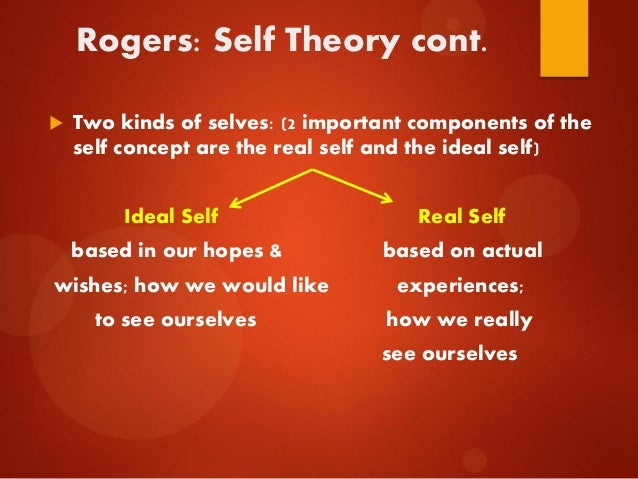The ideal self is created when our caregivers teach us that there is something wrong with our real self. It’s what develops when our immature emotional development is not encouraged, supported and treated with love and understanding, but is instead fed a healthy dose of shame. This means that self-actualization occurs when a person’s “ ideal self ” (i.e., who they would like to be) is congruent with their actual behavior (self-image). Rogers describes an individual who is actualizing as a fully functioning person. The main determinant of whether we will become self-actualized. The self-concept is the personal summary of who we believe we are; it is how we answer the question, “Who am I?” It includes our assessment of our positive and negative qualities, our relationships to others, our beliefs and opinions, and more. We acquire a self-concept in several ways, including the following. The Connection between Self concept (Actual Self Congruence & Ideal Self congruence) on Brand Preferences April 2014 International Journal of Management Excellence Volume 3(No.1):308-319. The actual self, which is the self-state representations of attributes someone (yourself or another person) believe you actually possess; the ideal self, or the self-state representations of attributes you or others would like you, ideally, to possess (i.e., a representation of someone's hopes, aspirations, or wishes for you);.
Have you ever considered that there is a real self and an ideal self? In this lesson, you will discover the difference between the two, and the effect of two selves at odds.


The lesson also offers a short quiz to help you measure your level of understanding.
Ideal Self Vs Real Self
Our Authors Write a Custom Essay
For Only $13.90/page!
order now
Real vs. Ideal Self
In psychology, the real self and the ideal self are terms used to describe personality domains. The real self is who we actually are. It is how we think, how we feel, look, and act.
The real self can be seen by others, but because we have no way of truly knowing how others view us, the real self is our self-image.The ideal self, on the other hand, is how we want to be. It is an idealized image that we have developed over time, based on what we have learned and experienced. The ideal self could include components of what our parents have taught us, what we admire in others, what our society promotes, and what we think is in our best interest.
The Importance Of Alignment
If the way that I am (the real self) is aligned with the way that I want to be (the ideal self), then I will feel a sense of mental well-being or peace of mind.
If the way that I am is not aligned with how I want to be, the incongruence, or lack of alignment, will result in mental distress or anxiety. The greater the level of incongruence between the ideal self and real self, the greater the level of resulting distress. Let’s take a look at some specific examples:Example #1: My ideal self-image includes honestyWhen my parents ask me why I was late coming home from a night out, and I am honest and tell them that I didn’t want to leave the party because I was having such a great time, then despite the ramifications (like being reprimanded), I will feel a sense of mental well-being.
If I am dishonest and tell them that my car wouldn’t start, then the misalignment between my real self and ideal self will result in mental distress or anxiety. The fact that I lied results in negative feelings.Example #2: My ideal self-image includes a strong work ethicIf I attend all of my college classes, read the assignments, study for the exams, and work hard on my term paper, the result will be a grade that is in line with a strong work ethic. I will feel peace of mind regarding the congruence between my ideal self and real self.I flunk out of a few college courses and I am put on academic probation. If I admit to myself that I did not keep up with the assigned readings, didn’t study for exams, and didn’t turn in my term papers, then I will feel distress or anxiety as a result of the discrepancy between my actual work ethic and the ideal work ethic that I have generated for myself.
Carl Rogers and Humanistic Psychology
Carl Rogers was a humanistic psychologist who theorized that we use denial and distortion as tactics to avoid the anxiety and distress we experience when our real and ideal self are not sufficiently aligned. Denial is when we don’t acknowledge and deal with the internal conflict, in an effort to avoid the anxiety. Distortion is about changing the facts related to the conflict, so that there is less or no anxiety. The more one uses these defenses, the greater the discrepancy between the ideal and real self becomes.

According to Carl Rogers, this can lead to a psychosis, a condition during which a person has a shattered identity.Rogers also theorized that the more our real self or self-image is aligned with our ideal self, the greater our true sense of self will be; this congruence between the real and ideal self results in high self-worth or self-esteem. In other words, if I want to feel good about myself, I will feel propelled to work toward an alignment between the real self and the ideal self. Carl Rogers referred to this as the process of self-actualization.

Lesson Summary
In psychology, the real self and the ideal self are terms used to describe personality domains. The real self is who I am and the ideal self is who I want to be.
The degree to which the two selves are congruent, is equal to the degree of peace of mind. The greater the discrepancy between the two, the greater the level of distress or anxiety. According to humanistic psychologist Carl Rogers, this can lead to a psychosis, a condition during which a person has a shattered identity.
Learning Outcomes
As you finish the video, you should try to:
- Distinguish between the ideal self and the real self
- Consider the mental distress that may occur due to incongruence between the ideal self and real self
- Describe Carl Rogers’ theories on denial and distortion in reference to the clash of real and ideal selves
- Define psychosis
Related posts:
The extent to which a person's ideals of themselves and their actual traits agree. A large discrepancy between the two can lead to psychological pain. It is that pain, in theory, that can lead an individual to seek treatment. It can be measured. The client sorts card describing their ideal selves and those describing the real self.
Actual Self And Ideal Self Drawing
Related Psychology Terms
Actual Self Vs Ideal Self


Comments are closed.